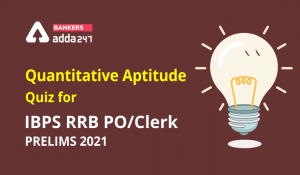Dear Students,
Quantitative Aptitude Quiz for Indian Bank PO Mains
Numerical Ability or Quantitative Aptitude Section has given heebie-jeebies to the aspirants when they appear for a banking examination. As the level of every other section is only getting complex and convoluted, there is no doubt that this section, too, makes your blood run cold. The questions asked in this section are calculative and very time-consuming. But once dealt with proper strategy, speed, and accuracy, this section can get you the maximum marks in the examination. Following is the Quantitative Aptitude quiz to help you practice with the best of latest pattern questions.
Directions (1-5): Which term is placed incorrectly in the following questions?
Q1. 190, 166, 145, 128, 112, 100, 91
(a) 190
(b) 145
(c) 128
(d) 100
(e) 91
Q2. 9261, 6859, 4913, 3376, 2197
(a) 9261
(b) 6859
(c) 4913
(d) 3376
(e) 2197
Q3. 625, 626, 945, 1881, 4703.5
(a) 625
(b) 626
(c) 1881
(d) 4703.5
(e) 945
Q4. 20, 35, 60, 106, 190, 355
(a) 20
(b) 35
(c) 60
(d) 106
(e) 190
Q5. 130, 340, 812.5, 2031.25, 5078.125
(a) 130
(b) 340
(c) 812.5
(d) 2031.25
(e) 5078.125
Q6. There are 3 containers A, B and C which contain water, milk and acid respectively in equal quantities. 10% of the content of A is taken out and poured into B. Then, the same 10% from B is transferred to C, from which again the same 10% is transferred to A. What is the proportion of milk in container A at the end of the process ?
(a) 9/10
(b) 1/11
(c) 1/121
(d) 10/1011
(e) None of these
Q7. A trader marked his goods at 20% above the cost price. He sold half the stock at the marked price, one quarter at a discount of 20% on the marked price and the rest at a discount of 40% on the marked price. His total gain is,
(a)2%
(b)15%
(c)2.75%
(d)13.5%
(e) None of these
Q8. A sum of money was invested for 12 years in Scheme A which offers simple interest at a rate of 10% p.a. The amount received from Scheme A after 12 years was then invested for two years in Scheme B which offers compound interest (compounded annually) at a rate of 15% p.a. If the interest received from Scheme B was Rs 7,095, what was the sum invested in Scheme A?
(a) Rs 9,500
(b) Rs 12,500
(c) Rs 11,500
(d) Rs 10,500
(e) Rs 10,000
Q9. A shopkeeper first allows a trade discount of 25% and then a cash discount of 32/5% on the marked price of the goods and gets a net gain of 17% of the cost. If marked price be RS.500/3,what will be the cost price?
(a)80
(b)100
(c) 105
(d)120
(e)75
Q10. A man can swim 45 m/min in still water swims 250m against the current and 250 m with the current. If the total time taken by man is 20 min, what is the speed of the current?
(a) 30 m/min
(b) 35 m/min
(c) 25 m/min
(d) 32 m/min
(e) None of these
Directions (11-14): In the given questions, two quantities are given, one as Quantity I and another as Quantity II. You have to determine relationship between two quantities and choose the appropriate option
Q11. The length of a passenger train moving at a speed of 45km/h is 250m. The length of a Rajdhani train is 750m which are moving at a speed of 135km/h.
Quantity I: Time taken by the passenger train to cross a person standing on the platform.
Quantity II: Time taken by the passenger train to cross the Rajdhani train coming from opposite direction.
(a) Quantity I > Quantity II
(b) Quantity I < Quantity II
(c) Quantity I ≥ Quantity II
(d) Quantity I ≤ Quantity II
(e) Quantity I = Quantity II or No relation
Q12. There are 3 vessels A, B and C full of mixture of milk and water. Vessel A contains 5 liters of water and 25 liters of milk, Vessel B contains 15 liters of water and 30 liters of milk and Vessel C contains water and milk in the ratio 1 : 5. 20%, 40% and 30% of the total mixtures from vessels A, B and C respectively is taken and poured into a fourth vessel. The ratio of milk and water in the fourth vessel is 16 : 5.
Quantity I: Capacity of vessel C in litres.
Quantity II: 80 litres.
(a) Quantity I > Quantity II
(b) Quantity I < Quantity II
(c) Quantity I ≥ Quantity II
(d) Quantity I ≤ Quantity II
(e) Quantity I = Quantity II or No relation
Q13. P, Q and R can complete a piece of work in 8, 12 and 24 days respectively. They work on alternate days.
Quantity I: Time taken by them to complete the work if P works on day 1, Q works on day 2 and R works on day 3 and so on.
Quantity II: Time taken by them to complete the work if Q works on day 1, R works on day 2 and P works on day 3 and so on.
(a) Quantity I > Quantity II
(b) Quantity I < Quantity II
(c) Quantity I ≥ Quantity II
(d) Quantity I ≤ Quantity II
(e) Quantity I = Quantity II or No relation
Q14. There are two bags A and B. Bag A contains 5 red, 3 green and 4 blue balls while Bag B contains 8 blue, 4 green and 6 red balls.
Quantity I: Probability of getting at most 1 red ball if 3 balls are drawn at random from Bag B.
Quantity II: Probability of getting at least 2 red balls if 3 balls are drawn at random from Bag A.
(a) Quantity I > Quantity II
(b) Quantity I < Quantity II
(c) Quantity I ≥ Quantity II
(d) Quantity I ≤ Quantity II
(e) Quantity I = Quantity II or No relation
Q15. A train moves at the speed of 144 km/hr, passes a platform and a bridge in 19 seconds and 39 seconds respectively. If the length of platform is one third of length of bridge, then find the length of train.
(a) 540 m
(b) 360m
(c) 420 m
(d) 340 m
(e) 600 m
You May also like to Read:
- Quantitative Aptitude Study Notes for Bank Exams
- 100 MCQs Data Interpretation | Download Free PDF’s of DI
- Quantitative Aptitude Questions for all Competitive Exams





 Quantitative Aptitude Quiz For IDBI AM/E...
Quantitative Aptitude Quiz For IDBI AM/E...
 Quantitative Aptitude Quiz For IBPS RRB ...
Quantitative Aptitude Quiz For IBPS RRB ...








